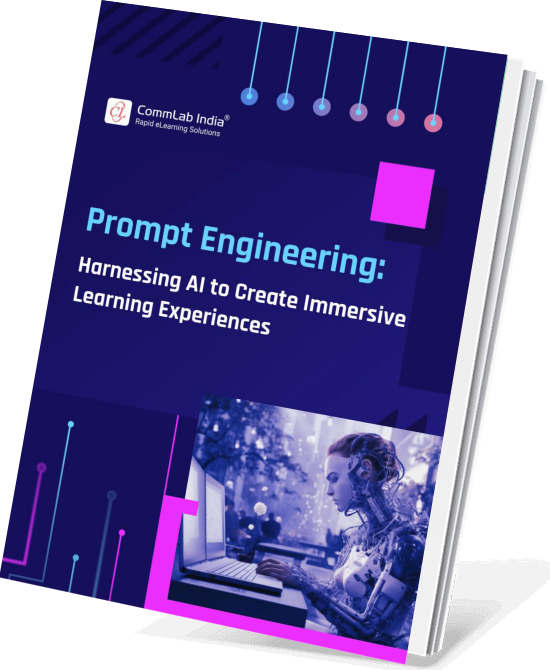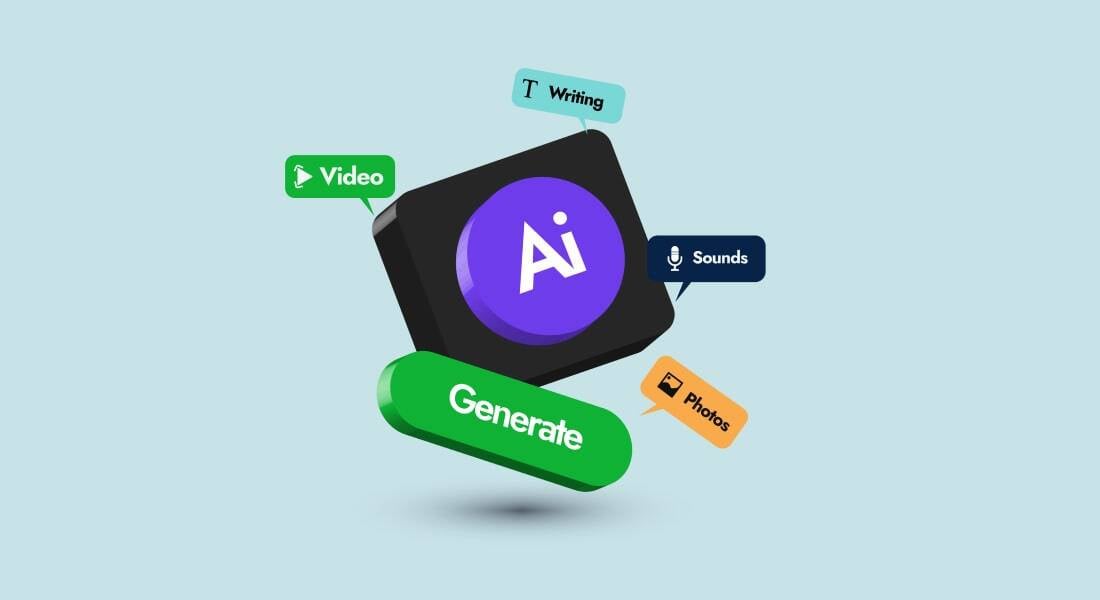Going Beyond the Basics: Advanced Techniques in Prompt Engineering

As AI tools become more integrated into Learning and Development (L&D), understanding the fundamentals of prompt engineering is crucial. But what if you’ve already mastered the basics and are looking to elevate your use of AI even further?
→ Download Now: Prompt Engineering for L&D Professionals!
Enter advanced prompt engineering techniques – strategies that enable you to unlock even more powerful and nuanced AI responses. In this blog, we'll explore these advanced techniques and show you how to apply them in corporate training, course development, and other L&D scenarios. By using context, personas, and multi-step reasoning, you can refine your prompts to generate highly specific, accurate, and creative content that goes beyond basic outputs.
Advanced Prompt Techniques
1. Contextual Prompting – Provide the AI with relevant context to shape its response accurately.
2. Personas – Ask the AI to adopt a specific role to generate tailored content.
3. Multi-Step Reasoning – Break down complex tasks into steps, allowing the AI to respond logically.
Overview of Advanced Prompt Techniques
At its core, prompt engineering involves giving AI clear, specific instructions to guide its response. However, advanced techniques take this one step further by enabling you to craft more intricate prompts that engage AI in deeper and more meaningful ways.
Let’s take a closer look at the key components of advanced prompt engineering:
- Contextual Prompting – Providing the AI with relevant context to shape its response more accurately.
- Personas – Asking the AI to adopt a specific role or perspective, which helps generate more tailored content.
- Multi-Step Reasoning – Breaking down complex tasks or problems into sequential steps, allowing the AI to process and respond more logically.
Each of these techniques allows you to customize your interactions with AI on a deeper level, enabling more sophisticated and specific outcomes.

Prompt Engineering — Harnessing AI to Create Immersive Learning Experiences
Learn the Art of Crafting Effective Prompts and Get Desired Outcomes
- What is Prompt Engineering?
- Why is Prompt Engineering Important?
- How to Craft Effective Prompts?
- And More!
Using Context, Personas, and Multi-Step Reasoning
Contextual Prompting
Providing context is one of the most effective ways to guide AI’s responses. When AI has a clear understanding of the scenario or subject matter, it can generate content that aligns more closely with your learning goals. Contextual prompts allow you to control not just the content, but also the tone, format, and depth of the response.
For example, instead of asking:
“Write an introduction to leadership styles,”
you could provide more context:
“You’re creating a corporate training module for mid-level managers on leadership. Write a 300-word introduction comparing transformational and transactional leadership styles, focusing on practical application in the workplace.”
By framing the prompt in a specific context, you’ll get a response that’s far more aligned with your needs.
Using Personas
A more advanced technique in prompt engineering is asking the AI to assume a persona—a specific role, voice, or character perspective. This allows you to create content that is more aligned with particular audiences or goals.
For example, in a corporate training context, you might ask the AI to adopt the persona of a subject matter expert or a consultant:
“Imagine you’re a senior HR consultant advising on employee retention strategies for a global corporation. Write a 500-word article on practical tips to reduce turnover in the tech industry.”
By assigning a role or persona, the AI can produce responses that are not only informative but also carry the expertise or tone you desire.
Personas can also be applied to make content more engaging or to tailor materials to specific groups of learners. For example, if you're developing a course for entry-level employees, you could specify that the AI takes on the voice of a mentor:
“Adopt the voice of a career mentor. Write a 400-word guide on time management for employees just starting their professional journey.”
Multi-Step Reasoning
Multi-step reasoning is an essential technique when working on complex projects. This involves breaking down a problem or request into smaller, sequential tasks that the AI can solve one step at a time. This method helps the AI process information more logically and deliver more structured, cohesive responses.
For instance, when creating an instructional module, rather than asking AI for the entire content at once, you could structure it as follows:
“Step 1: Write a 200-word overview of time management principles for busy professionals. Step 2: List three common time management challenges in corporate settings and provide solutions for each.
Step 3: Create a multiple-choice question to assess the learner’s understanding of time management strategies.”
This allows the AI to handle each component methodically, resulting in a more refined output. This technique is particularly useful when developing multi-faceted training materials, assessments, or scenarios.

Prompt Engineering — Harnessing AI to Create Immersive Learning Experiences
Learn the Art of Crafting Effective Prompts and Get Desired Outcomes
- What is Prompt Engineering?
- Why is Prompt Engineering Important?
- How to Craft Effective Prompts?
- And More!
Real-World Corporate Training Applications
Let’s now explore how these advanced prompt techniques can be applied in real-world corporate training scenarios. By integrating context, personas, and multi-step reasoning into your prompts, you can generate more specialized and effective learning content.
1. Designing Role-Specific Training
One of the best applications for advanced prompt engineering is developing content tailored to different roles within a company. By using personas and context, you can generate training materials that are highly relevant to your target audience.
For example, you might be designing a leadership training module for first-time managers. Using advanced prompting, you could provide the AI with clear parameters:
“Assume you are an executive leadership coach. Write a 500-word guide for first-time managers on how to balance team morale with achieving business goals. Focus on communication strategies and conflict resolution.”
This approach generates content that is directly applicable to the specific challenges first-time managers face, making it more valuable for learners.
2. Scenario-based Learning
Scenario-based learning is a powerful tool in corporate training, and advanced prompt engineering techniques make it easier to create realistic, dynamic scenarios. By using multi-step reasoning and personas, you can generate detailed, interactive case studies that reflect real-world challenges.
For example:
“You are designing a scenario for a diversity and inclusion training program.
Step 1: Create a conflict between two employees over cultural differences in communication styles.
Step 2: Write three possible outcomes for how the manager could address the conflict.
Step 3: Provide a multiple-choice question where learners choose the best resolution strategy.”
This multi-step reasoning approach helps create structured, layered content that can drive deeper learning and engagement.
3. Customizing Employee Assessments
Advanced prompt techniques are also useful for creating more nuanced employee assessments. Rather than generating generic quizzes, you can use context and multi-step reasoning to produce assessments that align closely with the learning objectives of a specific course.
For example:
“You are developing an assessment for a time management training course.
Step 1: Generate a multiple-choice question on prioritizing tasks using the Eisenhower Matrix.
Step 2: Provide a scenario where an employee is struggling with deadlines.
Step 3: Create a follow-up question asking learners to identify the time management strategy best suited to solving the problem.”
By guiding the AI through each step of the assessment creation process, you can produce more cohesive, relevant, and tailored quizzes that improve learner engagement and retention.
Tips for Applying Advanced Techniques Effectively
To get the most out of advanced prompt engineering techniques, here are a few practical tips:
1. Provide Ample Context
The more context you provide, the better the AI will understand your needs. Be clear about the subject matter, audience, tone, and format you’re expecting. This can help you generate outputs that are more aligned with your goals.
2. Be Iterative
Don’t be afraid to tweak and refine your prompts. If the first response isn’t quite what you’re looking for, adjust your prompt by providing more detail or rephrasing the task. Iterating allows you to guide the AI towards the best possible outcome.
3. Combine Techniques
To create truly powerful prompts, combine multiple advanced techniques. For instance, use both personas and multi-step reasoning to develop content that is not only accurate but also engaging and relevant to your learners.
4. Test and Experiment
AI tools are constantly evolving, so experimentation is key. Test different approaches, personas, and step-by-step processes to discover what works best for your specific use cases.
Advanced prompt engineering opens up new possibilities for creating highly specialized, relevant, and impactful content in L&D. By leveraging context, personas, and multi-step reasoning, you can enhance the precision and quality of AI-generated content, making it more applicable to real-world corporate training needs.
As AI continues to transform how we design and deliver learning experiences, mastering these advanced techniques will be essential for staying ahead of the curve. With the right approach, AI can become an invaluable tool in your content creation process—one that helps you produce more engaging, effective, and tailored training programs for learners across all levels of an organization.





